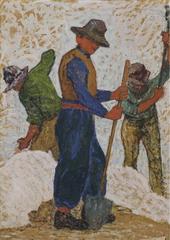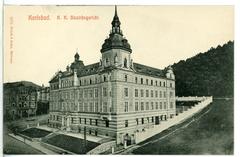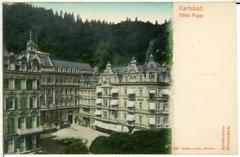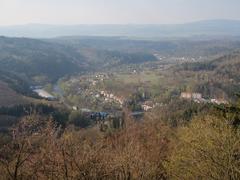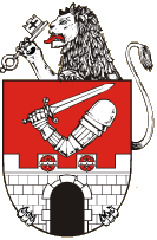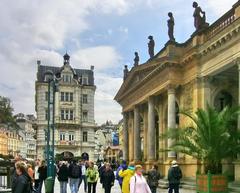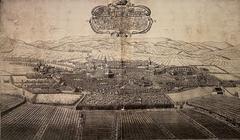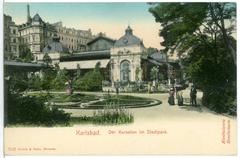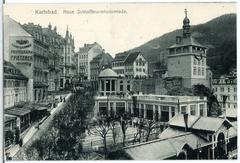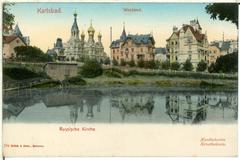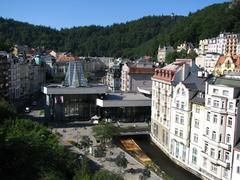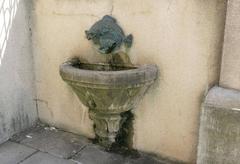
Statue Of The Turist Karlovy Vary: Visiting Hours, Tickets, and Historical Significance
Date: 04/07/2025
Introduction
Nestled in Western Bohemia, Karlovy Vary is a renowned spa town celebrated for its healing hot springs, elegant 19th-century architecture, and vibrant cultural heritage. Established in the 14th century by Charles IV, Holy Roman Emperor, it has attracted visitors for centuries, evolving into a modern destination that seamlessly blends historic charm with contemporary wellness tourism. One of its most engaging landmarks is the Statue Of The Turist—a life-sized bronze sculpture that humorously and thoughtfully embodies the spirit of today’s traveler. This statue is not only a nod to Karlovy Vary’s vital tourism sector but also a point of reflection on the shared experience of exploration and discovery (Karlovy Vary Official History, Karlovy Vary Tourist Information).
This guide provides detailed insights into visiting the Statue Of The Turist, including its symbolism, location, accessibility, practical tips, and its connection to Karlovy Vary’s broader historical and cultural context. You’ll also find information on nearby attractions, suggested itineraries, and recommendations for making the most of your visit.
Contents
- Introduction
- Historical Background of Karlovy Vary
- Visiting Karlovy Vary: Hours, Tickets & Accessibility
- Travel Tips and Getting There
- Nearby Attractions
- Special Events and Guided Tours
- Photographic Spots
- Frequently Asked Questions (FAQs)
- The Statue Of The Turist: History, Description, and Visitor Information
- Cultural and Symbolic Significance
- Practical Visitor Information
- Visuals and Media
- Conclusion
- Sources
Historical Background of Karlovy Vary
Early Settlement and Founding
The area now known as Karlovy Vary was inhabited as early as the late Bronze Age, with archaeological evidence in the Drahovice district. By the 13th century, Slavic communities utilized the region’s thermal springs. The village of Obora was first mentioned in 1325, but the town itself was founded around 1349 after Charles IV reportedly discovered the springs during a hunting expedition. He named the settlement “Karlovy Vary” (“Charles’ Baths”) and granted it royal privileges in 1370 (Wikipedia, Karlovy Vary Official History).
Development Through the Centuries
Karlovy Vary flourished as a spa destination by the 16th century, with over 200 spa buildings by the late 1500s. The city’s reputation grew among European aristocracy, artists, and intellectuals, especially after the construction of iconic colonnades and bathhouses in the 18th and 19th centuries (Prague.fm). Despite setbacks during wars and political changes, the town revived after the Velvet Revolution and joined the UNESCO World Heritage list in 2021 for its spa culture and architecture.
Visiting Karlovy Vary: Hours, Tickets & Accessibility
- Mill Colonnade: Open daily, typically 9 AM – 6 PM (free entry)
- Market Colonnade: Open 24/7 (free entry)
- Diana Lookout Tower: Open daily, 10 AM – 5 PM (entry ~100 CZK; funicular available)
- Spa Facilities: Most open 8 AM – 8 PM; check individual sites
- Accessibility: Major sites and promenades are wheelchair-friendly, though some cobbled streets may present challenges
Travel Tips and Getting There
- By Train/Bus: About 2.5 hours from Prague; Karlovy Vary International Airport nearby
- Best Time to Visit: Late spring to early autumn for mild weather and events
- Local Transport: Reliable bus system and funicular railway to Diana Tower
- Accommodation: Ranges from luxury hotels (e.g., Grandhotel Pupp) to guesthouses
Nearby Attractions
- Loket Castle: Medieval fortress, 10 km away
- Moser Glassworks: Museum and factory tours
- Becherovka Museum: Famous herbal liqueur
Special Events and Guided Tours
- International Film Festival: Held annually in July
- Spa Season Events: Concerts and festivals from May to September
- Guided Tours: Available in multiple languages; cover history, spa culture, and gastronomy
Photographic Spots
- Mill and Market Colonnades
- Diana Lookout Tower
- Hot springs and city fountains
Frequently Asked Questions (FAQs)
Q: Are tickets required for the colonnades?
A: No, most are free to visit.
Q: When is the best time to visit?
A: Late spring through early autumn.
Q: How do I book guided tours?
A: Through tourist information centers or online.
Q: Is Karlovy Vary family-friendly?
A: Yes—parks, promenades, and family events are plentiful.
The Statue Of The Turist: History, Description, and Visitor Information
Historical Background
The Statue Of The Turist (Socha Turisty) is a contemporary bronze sculpture, likely installed in the 2000s, created by a local artist as a tribute to the city’s ongoing relationship with visitors (Wikimedia Commons). Unlike older monuments such as the famous chamois statue at Jelení Skok, this statue humorously honors the modern traveler who shapes Karlovy Vary’s vibrant character (Karlovy Vary Tourist Information).
Artistic Description and Symbolism
The statue portrays a stereotypical tourist—complete with camera, backpack, sun hat, and guidebook—mid-stride and ready for adventure. The realistic yet whimsically exaggerated design highlights curiosity and exploration, inviting visitors to reflect on the universal experience of travel. Positioned on a low pedestal, it encourages close interaction and has become a popular spot for photos and social media posts.
Location and Accessibility
Situated on a main walking route to the Diana Observation Tower and Jelení Skok, the statue is easily reached on foot from the town center or via the funicular. The area is paved and wheelchair accessible, open to the public 24/7, and free to visit (The Crazy Tourist).
Visiting Hours and Tickets
- Visiting Hours: 24/7, year-round (outdoor public site)
- Tickets: None required
Visitor Experience and Practical Tips
- Best Time: Early mornings and late afternoons provide the best light and fewer crowds (My Wanderlust).
- Amenities: Nearby cafes, rest areas, and public restrooms
- Accessibility: Funicular provides access for those with limited mobility
Cultural and Symbolic Significance
Public Art and Identity
The Statue Of The Turist reflects Karlovy Vary’s self-awareness as a global tourist destination. Rather than commemorating a historical or religious figure, it celebrates the act of tourism itself—honoring the millions who contribute to the city’s vibrancy (Karlovy Vary official tourism).
Connection to Spa Heritage
The statue is a modern extension of the city’s centuries-old tradition of welcoming guests, bridging past and present by celebrating both the spa legacy and contemporary travel.
Artistic Context and Local Reception
Quickly embraced by locals and visitors, the statue stands out for its playful tone, contrasting with the formality of older monuments. Its popularity is reflected in frequent appearances on travel blogs and social media (Daily Travel Pill).
Educational and Economic Impact
Interpretive plaques and QR codes near the statue offer insights into its history and the role of tourism in Karlovy Vary. Tourism remains vital to the city’s economy, and the statue acknowledges the importance of visitors in sustaining local prosperity.
Practical Visitor Information
Getting There
- Funicular: Departs every 15 minutes from the city center (near Grandhotel Pupp)
- On Foot: Well-marked trails from the town center take 30–45 minutes
- By Car: Limited parking; public transport is recommended
Accessibility
The funicular and statue area are wheelchair-accessible, but some forest paths may be challenging for strollers or wheelchairs.
Facilities
- Restrooms and café at Diana Tower complex
- Souvenir kiosks (including Karlovy Vary spa cups)
- Benches and shaded areas
Combining with Other Attractions
- Diana Observation Tower: Panoramic city views
- Forest Trails: Routes to Deer Leap Lookout and Charles IV Lookout
- Colonnades and Hot Springs: Mill Colonnade for mineral water tasting (touristplaces.guide)
- Historic Architecture: Neo-Baroque and neo-Renaissance buildings along the Teplá River
Etiquette, Safety, and Communication
- Respect the statue; do not climb on it
- Use marked trails and be cautious on wet paths
- Czech is the official language, but English and German are widely spoken
Visuals and Media
- Wikimedia Commons: Statue Of The Turist
- High-quality images with alt text and interactive maps available on official tourism sites
Final Tips and Recommendations
The Statue Of The Turist encapsulates Karlovy Vary’s enduring relationship with visitors and its role as a premier spa destination. As a playful, meaningful public artwork, it bridges the city’s historic spa heritage with modern tourism. Its accessible location and free entry make it a must-see, especially when combined with nearby attractions like the Diana Observation Tower and historic colonnades.
Plan your visit by checking local schedules, utilizing mobile apps such as Audiala for offline maps and tour recommendations, and staying updated through official tourism platforms and social media. The statue is more than a monument—it is a living emblem of Karlovy Vary’s spirit, celebrating both tradition and the joys of travel (Karlovy Vary Official Tourism, The Crazy Tourist, Travelsewhere.net).
Sources and Further Reading
- Karlovy Vary Official History
- Karlovy Vary Tourist Information
- The Crazy Tourist
- Travelsewhere.net
- Wikipedia: Karlovy Vary
- Wikimedia Commons: Statue Of The Turist
- Prague.fm: Karlovy Vary
- Daily Travel Pill
- Touristplaces.guide
- My Wanderlust

